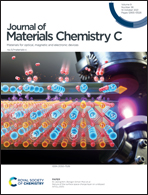Molecular design tactics enhancing the negative polaron stability of a p-type host for long device lifetime by fusion of carbazole with furan†
Abstract
A molecular design with a negative polaron stabilizing unit was developed to extend the device lifetime of blue phosphorescent organic light-emitting diodes (PhOLEDs). A novel p-type host material, 5,10-diphenyl-5,10-dihydrofuro[3,2-c:4,5-c′]dicarbazole (DBFBCzPh), with two carbazoles fused by a furan negative polaron stabilizing unit, was developed and synthesized in this work. A 9,9′-diphenyl-9H,9′H-3,3′-bicarbazole (BCzPh) p-type host material was used to compare the effect of the negative polaron stabilizing unit on the device characteristics. Compared with BCzPh, the DBFBCzPh showed improved stability against negative polarons, and thus the device lifetime was extended by more than two times. In the case of efficiency, the maximum external quantum efficiencies of the BCzPh and DBFBCzPh devices were 15.5% and 22.3%, respectively, in which the DBFBCzPh host containing a furan moiety showed 6.8% higher efficiency than the BCzPh host. Accordingly, the molecular design with the furan-based fused structure is advantageous in terms of both efficiency and device lifetime, and can be a platform for solving the lifetime issue of blue PhOLEDs.



 Please wait while we load your content...
Please wait while we load your content...